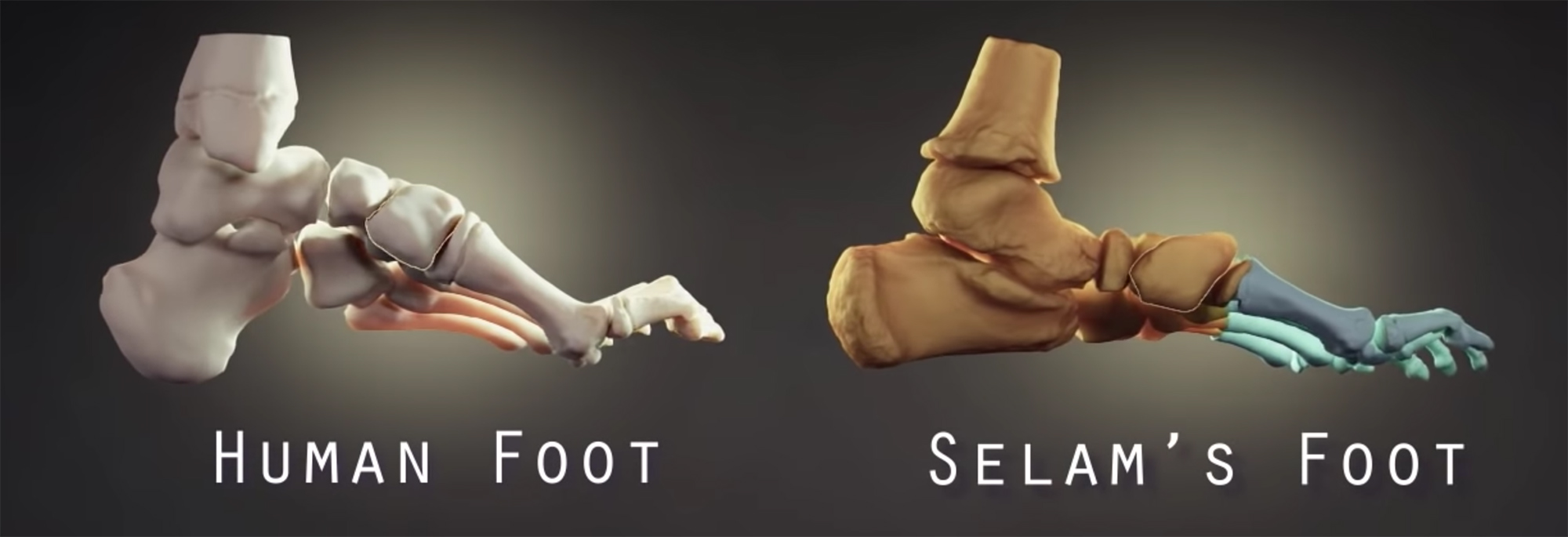
Selamʼs foot anatomy resembles a human foot in many ways; however, the differences reveal “apelike” adaptations. (Video still UChicago Medicine)
Researchers discover that ancient children climbed trees; develop new ways to build molecules; investigate the success of political outsiders; and examine the persistence of the racial earnings gap.
A better recipe for useful molecules
If you want to make an omelet, you’ve got to break a few eggs. If you want to make a molecule, you’ve got to convince the ingredients to attach in the right order. This process is notoriously fussy for arenes, a class of molecules useful in developing new pharmaceuticals and chemicals for agriculture. In a June 25 paper in Nature Chemistry, Guangbin Dong,professor of chemistry; graduate student and lead author Jianchun Wang; Renhe Li, SM’17; and Zhe Dong, PhD’18, found a better way. Their approach uses a palladium catalyst and molecules called bridgehead-modified norbornenes. The norbornenes serve as a bridge, allowing scientists to guide ingredients to the right spots. Making arenes used to be a seven-step process; with this new method, it’s only two.
Hey, get down from there!
Some childhood pastimes are timeless: a recent analysis of an ancient child’s fossilized foot suggests that, more than three million years ago, our youthful ancestors had adaptations that allowed them to climb trees. Zeresenay Alemseged was the senior author of the study, published in the July 4 Science Advances, which reveals that early humans retained certain apelike characteristics. Alemseged, professor in the Department of Organismal Biology and Anatomy, found the nearly complete skeleton of Selam, a two-and-a-half-year-old female Australopithecus afarensis, in Ethiopia. The skeletal structure of Selam’s foot indicates she could walk upright. But her big toe, which was more movable than an older Australopithecus afarensis’s and allowed her to grasp tree branches, suggests that children like Selam probably spent more time in trees than adults did. This likely provided juveniles a safe alternative to walking in moments of danger.
The stubborn racial earnings gap
The earnings gap between a median black man and a median white man is as wide today as it was in 1950. That’s the sobering conclusion of a July Becker Friedman Institute working paper by Kerwin Charles, the Edwin A. and Betty L. Bergman Distinguished Service Professor at Harris Public Policy. Charles and his coauthor studied the earnings of all working-age men, including those who are incarcerated or unemployed. They also analyzed the earnings gap in the top, middle, and bottom of the income distribution separately. The overall increase in earnings inequality, as well as the growing importance of education in the labor market, have disproportionately harmed black men, the researchers found.
Party crashers
In highly polarized political environments, outsider candidates can “crash” political parties and emerge victorious in elections, according to a new working paper from Peter Buisseret, an assistant professor at Harris Public Policy. With his coauthor, Buisseret developed a theoretical electoral model that explains the unanticipated success of nonestablishment candidates such as Donald Trump and Bernie Sanders, AB’64. These candidates, the research suggests, are often stronger in a general election than establishment candidates because their views and policies are aligned with the public, rather than with party elites. What’s more, the authors argue, party elites who could block the outsider’s nomination will often choose not to in the interest of party unity.
